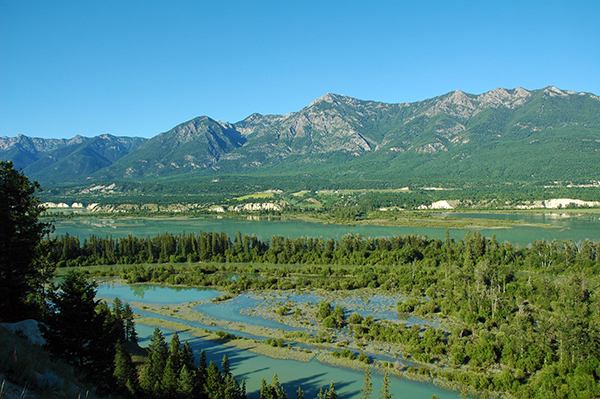Home »

Engagement and learning at the Columbia River headwaters
The Columbia River Basin is experiencing a historic moment of flux, with numerous changes, drivers of uncertainty, and upcoming decision points that will set the region’s course for decades.
That’s why watershed stewards, Indigenous representatives, community leaders, and youth came together to learn about the Columbia River Basin on Thursday, July 28.
 Participants joined the Real Estate Foundation of BC, Watersheds BC, the Healthy Watersheds Initiative, and Wildsight at the headwaters of the Columbia River to hear the Ktunaxa Creation story from Ktunaxa Elder Alfred Joseph.
Participants joined the Real Estate Foundation of BC, Watersheds BC, the Healthy Watersheds Initiative, and Wildsight at the headwaters of the Columbia River to hear the Ktunaxa Creation story from Ktunaxa Elder Alfred Joseph.
“The creation story told by Elder Joseph and Chief Pierre is a reminder that there is important historical evidence that show through time our Indigenous Peoples have a deep connection to the land that we steward, live and play on,” said Diana Cote. Cote is a member of the Shuswap Band and ʔakisq̓nuk First Nations and is the Indigenous Liaison with the B.C. Wildlife Federation. “We need to take a moment to remind ourselves that all places have meaning and a story.”
During the event, Cote shared more in her work with the BCWF’s Conservation Stewardship programs, which have been working alongside Indigenous Elders, youth, and community members in support of wetlands across B.C.
The telling of the creation story is one of the foundational learning experiences that students in Wildsight’s Columbia River Field School gain as they begin their journey through the watershed. Wildsight, an environmental NGO, has been running the Columbia River Field School since 2018. Local youth ages 15-18 spend 15 days canoeing along the Columbia River learning about the watershed’s past, present, and future, while developing skills and connections for their own futures.
Wildsight has been providing environmental education programs for more than two decades and interactive field schools to youth and educators for several years. Through support from the Real Estate Foundation of BC, Wildsight is building on this work through a new program called ‘Columbia River Futures.’
This program expands upon the experiential education programs of the Columbia River Field School to youth, educators, and, for the first time, government officials, so they can better contribute to the Columbia Basin’s future.

“The history of the Columbia Basin is grounded in the tremendous and largely under-acknowledged losses of the dam building era. To move forward, our communities must first understand what was lost, what new challenges we face, and what our options are, before we can build a shared vision for the future. Indigenous Nations and local community leaders are doing an outstanding job of advancing bold visions for our future. They have called on us to imagine a region that balances the hydro system with other values, that has its salmon back, that is prepared for climate disruption, and that is pioneering UNDRIP-informed governance and community self-determination. At Wildsight, our work aims to support these visions by fostering the potential and power of the next generation to carry them forward over decades to come,” said Robyn Duncan, Executive Director of Wildsight.
Elk River Monitoring and Protection
Other environmental NGOs are doing important work for wetlands and watersheds throughout the East Kootenay. Representatives from Living Lakes Canada and Elk River Alliance joined the tour and shared with participants aspects of the important watershed work they are doing in the region. Each of these organizations had projects funded through the Healthy Watersheds Initiative.
Elk River Alliance’s Community-Based Water Monitoring program is gathering data to monitor Elk River tributaries that are critical habitats for wildlife. By collecting data and identifying trends in ecosystem health, the Elk River Alliance will be able to create an early warning system to identify the effects of climate change and land use decisions. Elk River Alliance is also implementing stormwater treatment practices to preserve wetland and riparian areas in the Elk Valley.
“Through funding from the Healthy Watershed Initiative, we were able to increase staffing and really improve two of our programs,” said Chad Hughes, Executive Director of Elk River Alliance. “Our CBWM program is better equipped to monitor tributary health, and we plan to integrate the program into the wider Elk River Watershed Collaborative Monitoring Program to produce data and information for Elk River decision-makers and researchers. Likewise, with HWI funding we were able to better partner with Ktunaxa Nation on interpretive signage and pilot meaningful wetland improvements in our stormwater management systems.”
Engaging communities in watershed security
Over the past year, Living Lakes Canada has embarked upon delivering a unified monitoring framework for the Columbia Basin that reflects local water priorities to better understand the impacts of climate change on freshwater supply.
This involves engagement with First Nations, Elders, and local communities to ensure their values and water priorities are represented. Alongside the development of this framework, Living Lakes Canada has developed the Columbia Basin Water Hub database that holds the data collected. This hydrological resource was developed following the First Nations principles of OCAP.
Indigenous communities retain ownership over their data and have control over how their data is shared. In addition, the Living Lakes Canada Columbia Basin Groundwater Monitoring Program has helped establish groundwater observation wells in communities across the Basin, including ʔaq’am and Yaq̓it ʔa·knuqⱡi, and works with these communities to track groundwater levels over time.
“Living Lakes Canada works to protect and support management of precious watersheds in this era of climate impacts and has a commitment to respect and amplify Indigenous rights, voices, and leadership,” said Andy Miller, Deputy Director of Living Lakes Canada. “All of our projects share a dedication to upholding UNDRIP through water stewardship.”
The event concluded at Columbia Lake where Wildsight provided a modified lesson from their field school. Participants learned about the physical and human geography of the Columbia River Basin through analyzing and discussing a variety of different maps that highlight some of the features of and perspectives on the river.
“Being on the land at the headwaters of the Columbia River was very special,” said Deana Machin, a member of the Indigenous Leaders Advisory Circle for the Healthy Watersheds Initiative and a Member of the Syilx (Okanagan) Nation. “It really highlighted how important it is to continue to support Indigenous communities that are leading projects on their own territories and using the knowledge of the lands and waters to not only strengthen projects, but also as a way to further connect culture, language and community involvement.”
“As a funder, we work towards a future where freshwater ecosystems are healthy, sustainable, and valued. Wildsight’s Columbia River Futures program is providing unique opportunities for the public to learn and engage on the land and water with lessons that centre on Indigenous rights and title, relationships, and ways of knowing,” said Mark Gifford, CEO, Real Estate Foundation of BC. “Connecting to the water and land in this way is a powerful experience and will continue to inspire the stewardship of this critical watershed into the future.”
Lead image: Ktunaxa Elder Alfred Joseph with Mark Gifford, CEO, Real Estate Foundation of BC. Photos submitted
Submitted







